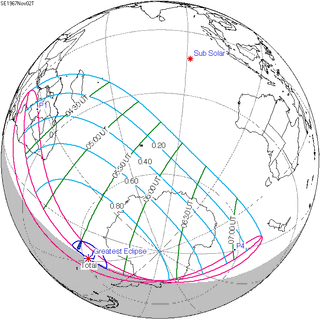| Solar eclipse of November 2, 1967 | |
|---|---|
| Type of eclipse | |
| Nature | Total |
| Gamma | 1.0007 |
| Magnitude | 1.0126 |
| Maximum eclipse | |
| Duration | - |
| Coordinates | 62°00′S 27°48′W / 62°S 27.8°W |
| Max. width of band | - km |
| Times (UTC) | |
| Greatest eclipse | 5:38:56 |
| References | |
| Saros | 152 (10 of 70) |
| Catalog # (SE5000) | 9437 |
A total solar eclipse occurred at the Moon's descending node of orbit on Thursday, November 2, 1967,[1] with a magnitude of 1.0126. A solar eclipse occurs when the Moon passes between Earth and the Sun, thereby totally or partly obscuring the image of the Sun for a viewer on Earth. A total solar eclipse occurs when the Moon's apparent diameter is larger than the Sun's, blocking all direct sunlight, turning day into darkness. Totality occurs in a narrow path across Earth's surface, with the partial solar eclipse visible over a surrounding region thousands of kilometres wide. Occurring only about 4 hours after perigee (on November 2, 1967, at 1:50 UTC), the Moon's apparent diameter was larger.[2]
It will be unusual in that while it is a total solar eclipse, it is not a central solar eclipse. A non-central eclipse is one where the center-line of totality does not intersect the surface of the Earth (when the gamma is between 0.9972 and 1.0260). Instead, the center line passes just above the Earth's surface. This rare type occurs when totality is only visible at sunset or sunrise in a polar region.
While totality was not visible for any land masses, a partial eclipse was visible for Southern Africa and Antarctica. This was the first of 55 umbral solar eclipses of Solar Saros 152.
- ^ "November 2, 1967 Total Solar Eclipse". timeanddate. Retrieved 8 August 2024.
- ^ "Moon Distances for London, United Kingdom, England". timeanddate. Retrieved 8 August 2024.
